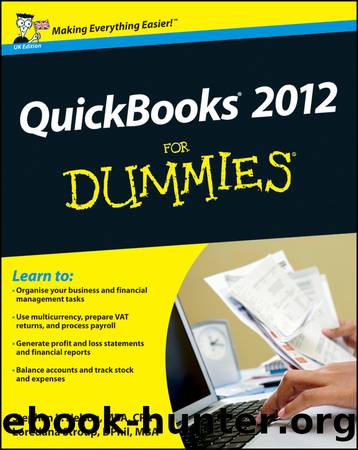QuickBooks 2012 For Dummies by Stephen L. Nelson

Author:Stephen L. Nelson
Language: eng
Format: epub
Publisher: Wiley
Published: 2012-01-10T00:00:00+00:00
Chapter 8
Working with Your Banking Register
In This Chapter
Some special circumstances for writing cheques
Recording deposits and transfers
Voiding and deleting transactions
Handling bounced cheques
Searching for transactions
The finances and cash flows of a business revolve around the bank account. Which means this chapter is mighty important. Here, youâre going to see how to do a number of everyday tasks that affect your bank account: writing certain types of cheque, making deposits, and handling bank transfers. Along the way, you also find out about some neat tools that QuickBooks provides for making these tasks easier, faster, and more precise.
When Only a Cheque Will Do
This chapter is all about transactions that affect your bank account, and the one thing that you do most often that affects your bank account is to write a cheque. In Chapter 6 we discuss, blow by blow, how to use the Write Cheques method to enter and pay your bills in one fell swoop, so we wonât repeat it here. But even if you typically use the accounts payable method (also described in Chapter 6) to handle supplier bills and payments, there are times when only the Write Cheques window will do. It may be because you donât have a bill from a supplier or itâs not the kind of transaction where a bill makes sense.
You find the Write Cheques window in QuickBooks by clicking BankingâWrite Cheques.
Here are some examples of instances where only the Write Cheques window will do:
You walk into a shop and see an item you must have (er, for the business, of course). You pay with your debit card and walk out happily with your new purchase (and a receipt). You enter this into QuickBooks in the Write Cheques window, exactly as described in Chapter 6, but instead of a cheque number you enter something such as DebitCard.
You use cold hard cash to pay for an expense out of the petty cash tin (see the sidebar later in this chapter on âPaying for items with cashâ).
You pay your business insurance premium by direct debit every year and you donât get a bill, just a reminder that itâs due. In the Write Cheques window, you use an expense account such as Insurance and the âEâ VAT Code (see Figure 8-1) â this is one of the few instances where you get to use the Exempt VAT Code. Enter something such as DD or DirectDebit for the cheque number.
Download
This site does not store any files on its server. We only index and link to content provided by other sites. Please contact the content providers to delete copyright contents if any and email us, we'll remove relevant links or contents immediately.
Secrets of the JavaScript Ninja by John Resig Bear Bibeault(5967)
Linux Device Driver Development Cookbook by Rodolfo Giometti(3445)
Implementing Enterprise Observability for Success by Manisha Agrawal and Karun Krishnannair(3216)
TCP IP by Todd Lammle(2646)
Drawing Shortcuts: Developing Quick Drawing Skills Using Today's Technology by Leggitt Jim(2537)
Pandas Cookbook by Theodore Petrou(2508)
Applied Predictive Modeling by Max Kuhn & Kjell Johnson(2486)
Supercharging Productivity with Trello by Brittany Joiner(2469)
Design Made Easy with Inkscape by Christopher Rogers(2324)
Mastering Tableau 2023 - Fourth Edition by Marleen Meier(2194)
Learn Qt 5: Build modern, responsive cross-platform desktop applications with Qt, C++, and QML by Nicholas Sherriff(2183)
40 Algorithms Every Programmer Should Know by Imran Ahmad(2165)
Build Stunning Real-time VFX with Unreal Engine 5 by Hrishikesh Andurlekar(2098)
Inkscape by Example by István Szép(2055)
Fusion 360 for Makers by Lydia Sloan Cline(1989)
Customizing Microsoft Teams by Gopi Kondameda(1901)
The Artificial Intelligence Imperative by Anastassia Lauterbach(1852)
Visualize Complex Processes with Microsoft Visio by David J Parker & Šenaj Lelić(1777)
The Old New Thing by Raymond Chen(1724)
